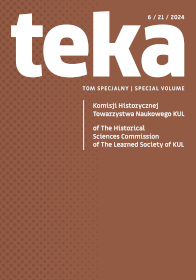Heinricha Kippinga Liber singularis de cruce et cruciariis w nurcie siedemnastowiecznego piśmiennictwa na temat krzyża jako narzędzia męki Chrystusa
Heinrich Kipping’s Liber singularis de cruce et cruriariis as an Work of 17th-century Literature on the Cross as the Instrument of Christ’s Torture
Author(s): Leszek WojciechowskiSubject(s): History, Modern Age, 17th Century
Published by: Towarzystwo Naukowe Katolickiego Uniwersytetu Lubelskiego Jana Pawła II
Keywords: Heinrich Kipping; Holy Rood; literature on Holy Rood; 17th century
Summary/Abstract: This article discusses the origins, structure and main theses contained in Liber singularis de cruce et cruciariis by Heinrich Kipping (1623-1678), a German scholar active in Bremen, a city that was in Swedish hands at the time. The work was printed there in 1671, and it represented literature devoted to the theme of the Cross, which developed from the mid-16 century to the late 17th-century. This period can be divided into several stages, and the most productive was from the 1590s to the 1620s. Kipping’s work in question belongs to the late period. This author examines various issues related to the shape of crosses and the penalty of crucifixion, inflicted on convicted criminals. Liber singularis is divided by 35 exercitationes. In each of them, Kipping presents a separate issue related to crosses and crucifixion. He makes use of the vast array of ancient and early Christian sources, also taking account of works written by 16th-century and 17th-century scholars dealing with the Holy Rood. Kipping proposes his own solutions to issues concerning the cross and the process of crucifixion, using the historical-philological method. The paper recapitulates the literary period in question.
Journal: Teka Komisji Historycznej Towarzystwa Naukowego KUL
- Issue Year: 21/2024
- Issue No: Special
- Page Range: 83-99
- Page Count: 17
- Language: Polish

